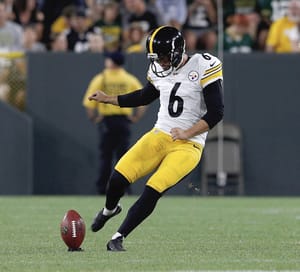Why Sign Matt Wile?

The Vikings made plenty of surprising moves over cutdown weekend, but lost in the emotion of Brian Robison and Terence Newman, or the euphoria of Chad Beebe making the practice squad, was a shocker on special teams.
By all accounts, Ryan Quigley had a fine 2017 season. In October, Mike Priefer said, “he’s doing exactly what we need him to do to help us win to eliminate the possibility of a big return, that’s our goal.” As it turns out, that trend continued. In 2017, Quigley only had 33.8% of his punts returned, 3rd fewest leaguewide.
As such, the Vikings never brought in a punting competition, save Hayden Hunt, a rookie out of Colorado State who never made it past a minicamp tryout. They even declined to bring in Marquette King, one of the most reputable punters in football.
But to everyone’s surprise, they cut Quigley on Saturday and picked up the relatively untested Matt Wile instead. After a season like 2017, why?
It’s first important to understand what sort of evidence actually help reveal whether a punter is good or not. As we’ve found out, a long punt isn’t necessarily a good one. A touchback cuts 20 yards off the field position gained, and “out kicking your coverage” can lead to dangerous returns with a head of steam.
Similarly, “net punt yards” (or the distance of the punt minus the return) don’t really tell us about the punter. Tray Matthews could miss a tackle leading to a return touchdown, and that has very little to do with the punter.
Mike Priefer values hangtime very highly, as that helps limit return opportunities for the other team. Distance isn’t so much of a concern. The logic here is that punt returns only kill you on explosive plays. The difference between 10 yards of field position has a smaller impact than the risk of a big return.
Quigley had a cool 4.55 seconds of average hangtime on his 56 punts in 2017. That tied for 4th leaguewide. In his preseason battle with rookie Taylor Symmank, he lost the distance, return and fair catch battles, but won the job based off 0.06 seconds more of average hangtime.
In the preseason, however, Quigley faltered. That 4.55 fell more than a full half second (4.01) – enough for a full step more for the returner before he has to start evading tacklers. As a result, 15 of Quigley’s 22 punts were returned, some to disastrous result. It makes sense that after such a performance, Priefer and the Vikings would look to make a change.
Meanwhile in Pittsburgh, Matt Wile was losing a punting battle to Jordan Berry. Wile had three tenths of a second more hangtime than Berry (2nd most hangtime of all preseason punters), more punts inside the 20, no touchbacks, and a longer average distance. More of Wile’s punts were returned, but with hangtime like his, that’s unlikely to sustain.
Matt Wile only punted during one regular season, 2016 in Atlanta and Arizona. Between the two teams, he averaged 4.50 seconds of hangtime on 12 punts, right on Quigley’s 2017 pace and not too far behind his own preseason 4.74. While the sample is small, Matt Wile’s punts have been remarkably consistent and exactly what the Vikings look for.
It could be seen as an overreaction to a few bad games from Quigley, who’s largely been consistent in the hangtime game even through the worst of his injury problems in New York and Arizona. That said, there’s nothing in Matt Wile’s career to date to bring up concern other than a lack of sample size.
This move is more likely drastic action taken to prevent the punt coverage woes of the preseason from translating into the regular season. Add that to cuts of players like Mike Needham and Jake Weineke, both of whom missed special teams tackles in the preseason, and it’s clear the Vikings have taken this problem seriously.
Thanks for reading!
